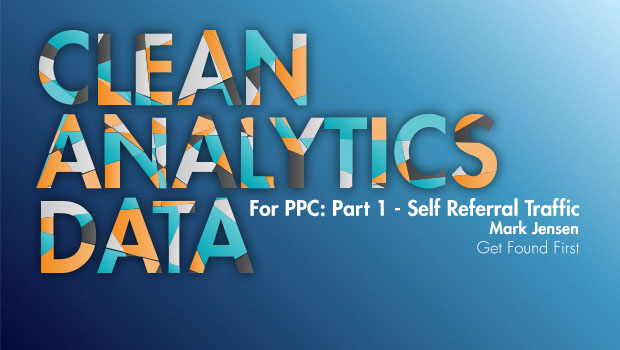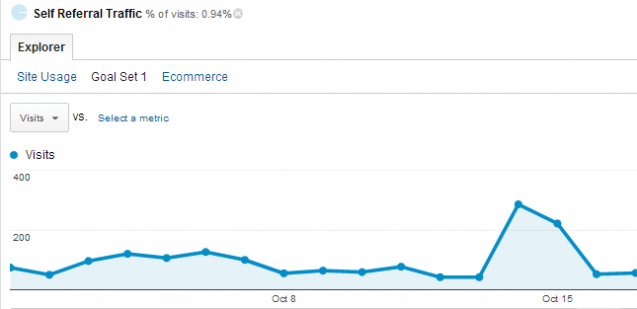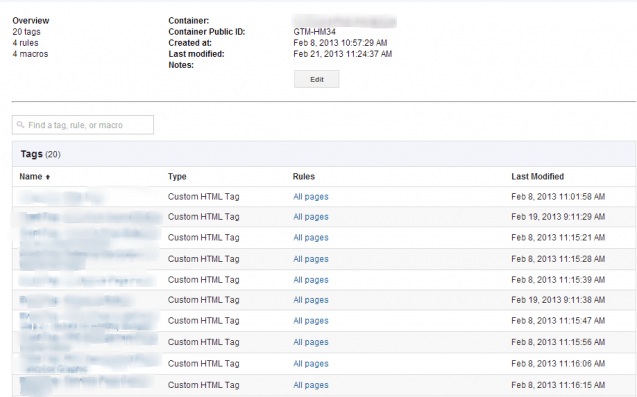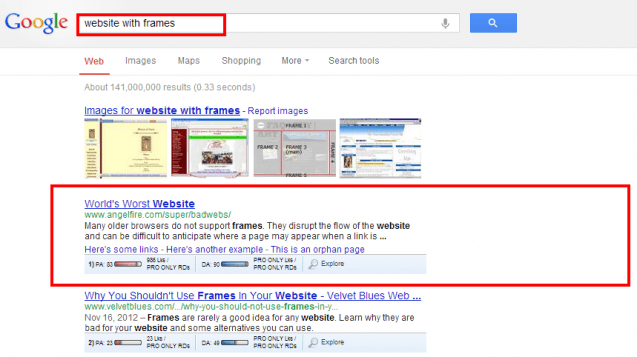
Self-Referring traffic can be a giant pay-per-click data pollution source.
Imagine sending your hard earned clicks to your website’s landing page. Along comes ‘Mr. Self-Referral’. Mr. Self-Referral grabs that click, any conversions gained by your traffic, and then takes your lunch money too. The real frustrating part is that now everyone thinks www.yourowndomain.com is where all that good website activity came from and it just got a conversion!
I know right?!
Self-Referrals destroy PPC analytics data.
In the image below, self-referral traffic only accounts for .94% of total visits. However, we have no idea how many of those visits originally came from paid search. Hundreds and thousands of clicks a client paid for are associated with potentially corrupted data.
Mom would not be impressed.

Following are some major causes and solutions to self-referral issues in Google Analytics.
Pages Missing Analytics Tags
If a website visitor moves from a webpage on your domain that is missing Google Analytics tags to a webpage on your domain that includes them that traffic will come in as self-referral.
Since the non-tagged page doesn’t have any cookie information to pass on it is tracked as a referral source.
Solution:
For an easy fix use a program like Screaming Frog to scan your website for pages that are missing your analytics property ID number. Simply go in and include your code.
To prevent this issue from arising I like to use Google Tag Manager to serve analytics tags to all pages on the website. For pages that need adjustments to the code (like e-commerce tracking) you can apply conditional rules and still make sure every page gets the proper tags.
Google Tag Manager does require some knowledge of regular expressions to maximize its potential. For those not using it, I highly recommend the program.

Google tag manager screenshot. We love it.
Pages with Incorrect Analytics Tags
Sometimes a PPC client will go through a number of agencies and IT employees before they get to us. It’s not surprising to see a few different analytic tag formats and even property ID numbers throughout a website.
When a visitor moves from a webpage with an incorrect analytics tag to a page with the correct tag you can often receive a self-referral. This will always result in a self-referral if the property ID numbers are different.
Solution:
Again, you can use a tool like Screaming Frog to identify pages without your property ID numbers. You can also use a tag manager platform to make sure all the tags are uniform and firing correctly.
For scenarios where the client’s website is a giant code disaster you may need to get their IT department to do an in-depth clean up.
Positioning of Analytics Tags
There really is a reason Google tells you to install your analytics tags in the header. If an analytics tag doesn’t fire before the visitor moves to the next page on your website that page doesn’t send any data to the next page’s tag. The result? Self-referral.
Solution:
Always install analytics tracking code in your website header unless otherwise directed by the tracking code publisher.
No “http://www” and “http” Website redirects
It’s important to remember that Google Analytics see’s www.website.com and http://website.com as two separate entities. If a visitor comes to www.website.com/page and goes to http://website.com/home you will see referral traffic from www.website.com/page.
Solution:
If you haven’t set up a server side redirect for www.website.com, http://website.com, www.website.com/index.html, etc, we suggest doing so. You’ll want to redirect to the base URL you are currently tracking in analytics.
Frames
They’re ugly and bad. Frames are bad. Get rid of them because they ruin lives.
A frame will essentially load two webpages on one page. If the frame doesn’t have analytics tracking code, you’ve got self-referral problems. If the frame does include analytics tracking code then now you’ve got two analytic tags firing and, yes, you’ll likely have problems.
Solution:
Get rid of frames. If that’s unavoidable you may need to employee some fancy coding or just see the ‘magic bullet’ section in this article.
Also, don’t format with tables. This won’t affect self-referrals at all but it is very bad coding and makes me cringe.

Please see Google search result #1 for ‘website with frames’.
Splash Pages
This one is mentioned in Google’s help article about self-referrals (here). I don’t think this should be as much of an issue as it was in the 90s but… here it is.
If a splash page doesn’t have the correct tracking code or doesn’t have tracking code you’ll have a self-referral.
Solution:
If you have a splash page for your website make sure you have the proper code installed. Simple.
Sometimes splash pages are hosted on separate domains. If this is the case stay tuned for future ‘Cleaning Analytics for PPC’ articles.
The ‘Magic Bullet’
Sometimes you’ll have self-referrals and after all you can do it’s just no longer worth your time to figure out. Introduce: IgnoredRef method.
To utilize the IgnoredRef method you will need to add the following line to your Google Analytics Tracking code:
_gaq.push([‘_addIgnoredRef’, ‘yourwebsite.com’]);
The IgnoredRef method will tell Google Analytics to take any traffic is sees coming in as a referral from the website you specify and mark it as direct traffic.
What this does is allow you to get rid of ALL self-referrals in a single swoop.
What this DOES NOT do is magically create clean data. It will simply create a direct visit instead of a referral visit. While this method is helpful for cleaning up referral data it has now polluted direct visit data.
For example:
You are running a paid search ad and get a click. Google Analytics tracks the visitor’s activity as coming from the source and medium ‘Google / AdWords’. The visitor now goes to your landing page and a few other pages on your website. In their website travels the visitor lands on a page of yours that doesn’t have Google Analytics tag installed.
With or without the IgnoredRef method any additional website activity for this visitor will not be recorded as coming from AdWords.
If you have implemented the IgnoredRef method, that visit will simply not be counted as a referral visit. It will be counted as coming from a direct source.
Have you found any other frequent causes of Self-Referral traffic? Have you devised your own methods for dealing with them?
If so, please share below!




